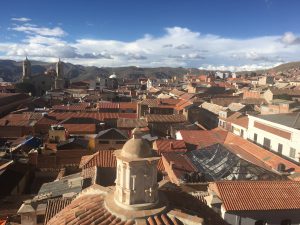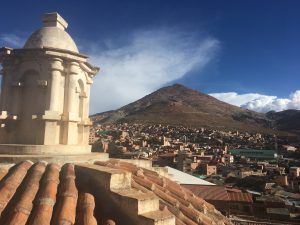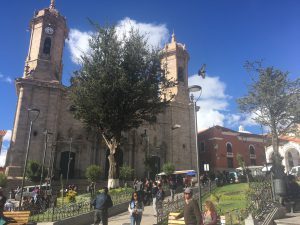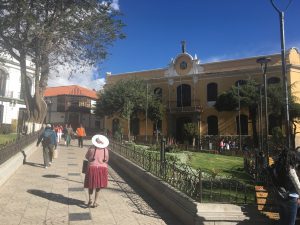If you are interested in my trip, I travelled with G Adventures for 2 weeks on their Buenos Aires to La Paz Adventure which you can read more about here.
NB. This page has affiliate links. If you choose to purchase any of the products I have recommended or make a booking through my website, I may receive a small commission. This doesn’t affect the price you pay and helps keep my site running. For more information please see my affiliate disclosure 🙂
 Down the silver mines today! Pedro, our guide and an ex-miner had a great deal to tell us and with infectious enthusiasm! He was saying how he loves bringing tourists to the mines as it makes more money for the miners. Potosi was founded in 1545 as a mining town and soon produced great wealth. The mountain that the mines are in, the Cerro Rico, produced an estimated 60{b9e09a1f0ec7fb6a299d86e341da000a37fb406ebc3c1b2f25bdf27407077a30} of all silver mined during the second half of the 16th century. In fact, the city’s silver once bank-rolled the entire Spanish empire. But not without the tragic cost of many lives, mostly slaves brought in to build the mines.
Down the silver mines today! Pedro, our guide and an ex-miner had a great deal to tell us and with infectious enthusiasm! He was saying how he loves bringing tourists to the mines as it makes more money for the miners. Potosi was founded in 1545 as a mining town and soon produced great wealth. The mountain that the mines are in, the Cerro Rico, produced an estimated 60{b9e09a1f0ec7fb6a299d86e341da000a37fb406ebc3c1b2f25bdf27407077a30} of all silver mined during the second half of the 16th century. In fact, the city’s silver once bank-rolled the entire Spanish empire. But not without the tragic cost of many lives, mostly slaves brought in to build the mines.
The mine is still working and still producing silver, but also lead, zinc and tin. It’s owned by the government and all the miners are self-employed so how much they make each week depends on the minerals they find. And obviously this can vary hugely! We were all really feeling the altitude at the top of the mountain (which is at the top of the highest city in the world!) so were given coca leaves to chew. They taste like spinach water and really aren’t very nice….even when Pedro gave us a salty quinoa addition to add to it (to supposedly create more saliva). The mines were extremely narrow and dusty and it was pretty unnerving at times, especially when we had to leap over gaps with drops that were about 5 people tall.  They blew up a part of the mine whilst we there as well which, even though we knew it was going to happen, made us all jump out our skins! I think its human nature to jump when you hear a loud boom and are stuck underground. Not nice at all! Pedro pointed out the various ‘shrines’ along the way, including a bear made of stone which is their ‘god of the mines’. We gave him coca leaves and beer to keep us safe….I think we were all relieved when we saw daylight again!
They blew up a part of the mine whilst we there as well which, even though we knew it was going to happen, made us all jump out our skins! I think its human nature to jump when you hear a loud boom and are stuck underground. Not nice at all! Pedro pointed out the various ‘shrines’ along the way, including a bear made of stone which is their ‘god of the mines’. We gave him coca leaves and beer to keep us safe….I think we were all relieved when we saw daylight again!
 That evening we went to a (quite grotty) karaoke bar where they only sold spirits by the bottle. Or beer. (No wine). You can tell what kind of a night its going to be. Haha. Poppy and I shared a bottle of a local spirit (I can’t remember the name) which was similar to vodka (but I’m sure more potent). And needless to say, it turned into quite a drunken night, singing and dancing with the locals. The final four of us left about 2.15am and even though the hotel was less than 10 minutes walk away, none of us could remember which direction it was in….after 20 minutes of walking the streets we ended up back at the karaoke bar! We finally found it and collapsed into bed.
That evening we went to a (quite grotty) karaoke bar where they only sold spirits by the bottle. Or beer. (No wine). You can tell what kind of a night its going to be. Haha. Poppy and I shared a bottle of a local spirit (I can’t remember the name) which was similar to vodka (but I’m sure more potent). And needless to say, it turned into quite a drunken night, singing and dancing with the locals. The final four of us left about 2.15am and even though the hotel was less than 10 minutes walk away, none of us could remember which direction it was in….after 20 minutes of walking the streets we ended up back at the karaoke bar! We finally found it and collapsed into bed.
 Our bus ride to Sucre the next day was fairly subdued unsurprisingly. When we arrived there was a huge parade going on for carnival (which tends to last the whole of February) which was cool. Sucre is a lovely town, it actually reminded me a of a tuscan hilltop town. All the buildings are white, a lot with red roofs and the town has a wealthy feel to it. It feels quite different to the rest of Bolivia, I kept thinking I was back in Argentina or Chile. We had lunch at a lovely little courtyard cafe (well, it was lovely at the time), but unfortunately I projectile vomited it back up that evening and had terrible stomach cramps! All in the midst of one of the most amazing thunderstorms I’d ever heard too – extremely heavy rain and then hail! Being sick meant I missed going to the market the next day which was a shame. And I wasn’t the only one – apparently its pretty common that tourists get ill in Bolivia. So I had a quiet day, slept till lunch and then had a slow wander round Sucre and managed half a bowl of soup! Luckily it was only a 24-hour thing so I was much improved by that night – which was a good thing as we had to get a night bus to La Paz.
Our bus ride to Sucre the next day was fairly subdued unsurprisingly. When we arrived there was a huge parade going on for carnival (which tends to last the whole of February) which was cool. Sucre is a lovely town, it actually reminded me a of a tuscan hilltop town. All the buildings are white, a lot with red roofs and the town has a wealthy feel to it. It feels quite different to the rest of Bolivia, I kept thinking I was back in Argentina or Chile. We had lunch at a lovely little courtyard cafe (well, it was lovely at the time), but unfortunately I projectile vomited it back up that evening and had terrible stomach cramps! All in the midst of one of the most amazing thunderstorms I’d ever heard too – extremely heavy rain and then hail! Being sick meant I missed going to the market the next day which was a shame. And I wasn’t the only one – apparently its pretty common that tourists get ill in Bolivia. So I had a quiet day, slept till lunch and then had a slow wander round Sucre and managed half a bowl of soup! Luckily it was only a 24-hour thing so I was much improved by that night – which was a good thing as we had to get a night bus to La Paz.  It was a pretty comfy bus and went surprisingly quickly (I had a fair few distractions including them showing a film on the bus). I managed perhaps 3 hours sleep but didn’t feel too bad when we arrived into La Paz.
It was a pretty comfy bus and went surprisingly quickly (I had a fair few distractions including them showing a film on the bus). I managed perhaps 3 hours sleep but didn’t feel too bad when we arrived into La Paz.
If you are interested in my trip, I travelled with G Adventures for 2 weeks on their Buenos Aires to La Paz Adventure which you can read more about here.
What a fantastic adventure. I would love to take a trip down a mine and see what it looks like. Sounds like an amazing trip. The pictures are beautiful and it looks like the weather was great as well. I had no idea there used to be so much silver there. Too bad you got sick, sounds like a common thing that happens. What was your favorite part of Potosi?
Hi, thanks for your comments 🙂
It was fantastic – such an unusual place to visit. My favourite part of Potosi was the main square I think – it was great for people watching and just being in the hostel and bustle of everyone going about their business 🙂
Louise
Oh my!!! You sure had a great time. Sorry to hear that you were sick and thank goodness it only lasted a few hours. It’s not always fun when you fall sick on a trip.
Two things caught my attention here – visiting the mine and Sucre town. Sucre town sounds peaceful. It reminds me of a little town in Scotland called Paisley.
Thanks for sharing this story.
Looks like a very beautiful place, for a photographer like myself it would be as if I stuck gold. That’s amazing an experience, I would’ve been a little nervous, but hey at least you got to experience something many people probably won’t get to. That’s pretty cool how that miners are self-employed, I hope to be self-employed one of these days. Sucks that you got sick, but at least you’re better now, ready for another adventure! 🙂
Wow what a unique experience you must have had in the silver mines. That’s great that the tourism supports the miners.
Do you know what the elevation was at the top of the mountain? I do a lot of hiking at high altitude and have gotten sick before. I had heard coca leaves can help with this but I’ve never talked with someone who used them firsthand. Did they seem to help?
Hi Katie,
I think it was just under 5000m? I luckily didn’t get sick but about half of our group did. I didn’t really notice the coca leaves doing much – if anything they just made my mouth numb! However, some of the locals swear by them and one of the girls in my group thought it seemed to help.
Louise